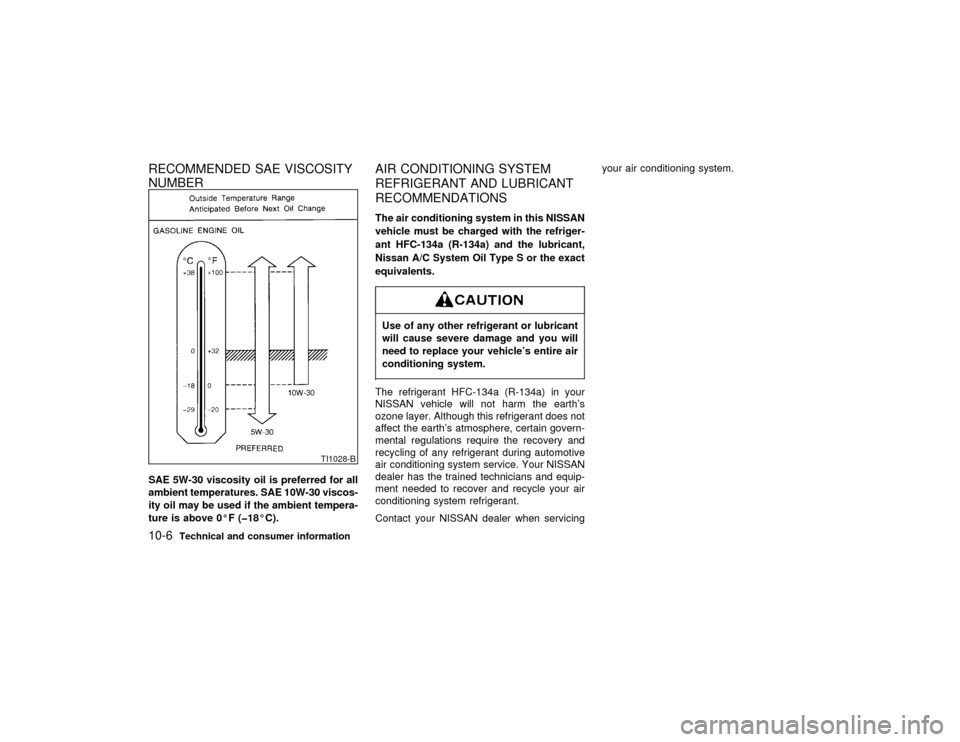1998 NISSAN MAXIMA air conditioning
[x] Cancel search: air conditioningPage 93 of 231

Air recirculation buttonOFF position:
Outside air is drawn into the passenger com-
partment.
Use the off position for normal heater, or air
conditioner operation.
ON position (Indicator light ON):
Interior air is recirculated inside the vehicle.
Push the air recirculation button to the ON
position when driving on a dusty road or to
avoid traffic fumes and for maximum cooling
when using the air conditioner.Air conditioning buttonThis button is provided only for vehicles with
air conditioner.
Start the engine, move the fan control dial to
the desired (1 to 4) position and push the air
conditioning button to turn on the air condi-
tioner. The indicator light will come on when
the air conditioner is on. To stop the air con-
ditioner, push the switch again to return it to
the original position.
The air conditioner cooling function oper-
ates only when the engine is running.
HEATER OPERATION
HeatingThis mode is used to direct hot air from the
floor outlets. Some air will also come from the
defrost vents.
1. Push the air recirculation button to the OFF
position for normal heating.
2. Push the
button in.
3. Turn on the fan control dial.
4. Move the temperature control lever to the
desired position between the middle and
the HOT position.
For quick heating, move the air recirculation
button to the ON position. Be sure to return the
air recirculation button to the OFF position for
normal heating.
VentilationThis mode directs outside air from the side and
center vents.
1. Push the air recirculation button to the OFF
position.
2. Push the
button in.
3. Turn on the fan control dial.4. Move the temperature control lever to the
desired position.
Defrosting or defoggingThis mode is used to defrost/defog the win-
dows.
1. Push the
button in.
2. Turn on the fan control dial.
3. Move the temperature control lever to the
desired position between the middle and
the HOT position.
ITo quickly remove ice or fog from the
windows, turn on the fan control dial to 4
and the temperature control lever to the full
HOT position.
IWhen thebutton is pushed, the air
conditioner will automatically be turned on
to defog the windshield, and the air recircu-
late mode will automatically be turned off.
Outside air is drawn into the passenger
compartment to improve the defogging per-
formance.
4-4
Heater, air conditioner and audio systems
Z
01.1.31/A32-D
X
Page 94 of 231

Bi-level heatingThis mode directs outside air from the side and
center vents and hot air from the floor outlets.
1. Push the air recirculation button to the OFF
position.
2. Push the
button in.
3. Turn on the fan control dial.
4. Normally move the temperature control le-
ver to the midpoint between HOT and
COLD.
Heating and defoggingThis mode heats the interior and defogs the
windshield.
1. Push the
button in.
2. Turn on the fan control dial.
3. Move the temperature control lever to the
desired position between the middle and
the HOT position.
Operating tipsIClear snow and ice from the wiper
blades and air inlet in front of the wind-
shield. This will improve heater opera-
tion.
IWhen the
button is pushed, the air
recirculate mode will automatically be
turned off.
Outside air is drawn into the passenger
compartment to improve the defogging per-
formance.
AIR CONDITIONER OPERATIONStart the engine, move the fan control dial to
the desired (1 to 4) position and push in the air
conditioning button to activate the air condi-
tioner. When the air conditioner is on, cooling
and dehumidifying functions will be added to
the heater operation.CoolingThis mode is used to cool and dehumidify.
1. Push the air recirculation button to the OFF
position.
2. Push the
button in.
3. Turn on the fan control dial.
4. Push on the air conditioning button. The
indicator light will come on.
5. Move the temperature control lever to the
desired position.
For quick cooling when the outside tempera-
ture is high, move the air recirculation button to
the ON position. Be sure to return the air
recirculation button to the OFF position for
normal cooling.
Heater, air conditioner and audio systems
4-5
Z
01.1.31/A32-D
X
Page 95 of 231

Dehumidified heatingThis mode is used to heat and dehumidify.
1. Push the air recirculation button to the OFF
position.
2. Push the
button in.
3. Turn on the fan control dial.
4. Push on the air conditioning button. The
indicator light will come on.
5. Move the temperature control lever to the
desired position.
Dehumidified defoggingThis mode is used to defog the windows and
dehumidify.
1. Push the
button in.
2. Turn on the fan control dial.
3. Push on the air conditioning button. The
indicator light will come on.
4. Move the temperature control lever to the
desired position.
When thebutton is pushed, the air con-
ditioner will automatically be turned on to de-
fog the windshield, and the air recirculate
mode will automatically be turned off.Outside air is drawn into the passenger com-
partment to improve the defogging perfor-
mance.
Operating tipsIKeep the windows and sun roof closed
while the air conditioner is in operation.
IAfter parking in the sun, drive for 2 or 3
minutes with the windows open to vent hot
air from the passenger compartment. Then,
close the windows. This will allow the air
conditioner to cool the interior more quickly.
IThe air conditioning system should be
operated for about 10 minutes at least
once a month. This helps prevent dam-
age to the system due to lack of lubrica-
tion.
IIf the coolant temperature gauge exceeds
the HOT position, turn the air conditioning
off. For additional information, see ªIf your
vehicle overheatsº in the ª6. In case of
emergencyº section.
AIR FLOW CHARTSThe chart below shows the button and lever
positions formaximum and quickheating,
cooling or defrosting.
The air recirculation button should be in
the OFF position for normal cooling, heat-
ing and defrosting.
4-6
Heater, air conditioner and audio systems
Z
01.1.31/A32-D
X
Page 101 of 231

The air conditioning system in your NISSAN
vehicle is charged with a refrigerant designed
with the environment in mind.This refrigerant
will not harm the earth's ozone layer.How-
ever, special charging equipment and lubricant
are required when servicing your NISSAN air
conditioner. Using improper refrigerants or lu-
bricants will cause severe damage to your air
conditioning system. See ªCapacities and rec-
ommended fuel/lubricantsº in the ª10. Techni-
cal and consumer informationº section for air
conditioning system refrigerant and lubricant
recommendations.
Your NISSAN dealer will be able to service
your environmentally friendly air conditioning
system.The air conditioner system contains re-
frigerant under high pressure. To avoid
personal injury, any air conditioner ser-
vice should be done only by an experi-
enced technician with proper
equipment.
RADIOTo turn the radio on, turn the ignition key to
ACC or ON. If you listen to the radio with the
engine not running, turn the key to the ACC
position.
Radio reception is affected by station signal
strength, distance from radio transmitter, build-
ings, bridges, mountains and other external
influences. Intermittent changes in reception
quality normally are caused by these external
influences.
SERVICING AIR CONDITIONER AUDIO SYSTEM4-12
Heater, air conditioner and audio systems
Z
01.1.31/A32-D
X
Page 205 of 231

The following are approximate capacities. The actual refill capacities may be a little
different. When refilling, follow the procedure instructed in the ª8. Do-it-yourselfº section
to determine the proper refill capacity.
Capacity (Approximate)
Recommended
specifications US
measureImp
measureLiter
Fuel 18-1/2 gal 15-3/8 gal 70Unleaded gasoline with an octane rating
of at least 91 AKI (RON 96)
Engine oil (Refill)
With oil filter 4-1/4 qt 3-1/2 qt 4.0IAPI SG or SH and Energy Conserving
II*1, *2
IAPI Certification Mark*1, *2 Without oil filter 3-7/8 qt 3-1/4 qt 3.7
Cooling system
With reservoir 9 qt 7-1/2 qt 8.5
Anti-freeze coolant
(Ethylene glycol base)
Reservoir 7/8 qt 3/4 qt 0.8
Manual transmission gear oilÐ Ð Ð API GL-4, Viscosity SAE 80W-90 only
Automatic transmission fluid
Refill to the proper oil level according
to the instructions in the ª8. Do-it-
yourselfº section.Nissan Matic ªDº (Continental U.S. and
Alaska) or Genuine Nissan Automatic
Transmission Fluid (Canada).*3
Power steering fluid Type DEXRON
TMIII or equivalent
Brake and clutch fluidGenuine Nissan Brake Fluid*4 or equiva-
lent DOT 3 (US FMVSS No. 116)
Multi-purpose greaseÐ Ð Ð NLGI No. 2 (Lithium soap base)
Air conditioning system refrigerantÐ Ð Ð HFC-134a (R-134a)
Air conditioning system lubricants Ð Ð ÐNissan A/C System Oil
Type S or exact equivalent
*1: For additional information, see later in ªCapacities and recommended fuel/lubricantsº for engine oil and oil filter recommendation.
*2: For additional information, see later in ªCapacities and recommended fuel/lubricantsº for recommended SAE viscosity number.
*3: Dexron
TMIII/Mercon
TMor equivalent may also be used. Outside the continental United States and Alaska contact a NISSAN dealer for
more information regarding suitable fluids, including recommended brand(s) of Dexron
TMIII/Mercon
TMautomatic transmission fluid.
*4: Available in mainland US through your NISSAN.
FUEL RECOMMENDATIONUnleaded premium gasoline with an octane
rating of at least 91 AKI (Anti-Knock Index)
number (Research octane number 96)
If unleaded premium gasoline is not avail-
able, unleaded regular gasoline with an
octane rating of at least 87 AKI (Research
octane number 91) can be used.
However, for maximum vehicle perfor-
mance, the use of unleaded premium gaso-
line is recommended.Using a fuel other than that specified
could adversely affect the emission con-
trol devices and systems, and could
also affect the warranty coverage.
Under no circumstances should a
leaded gasoline be used, since this will
damage the three-way catalyst.Reformulated gasolineSome fuel suppliers are now producing refor-
mulated gasolines. These gasolines are spe-
cially designed to reduce vehicle emissions.
CAPACITIES AND
RECOMMENDED
FUEL/LUBRICANTS10-2
Technical and consumer information
Z
01.1.31/A32-D
X
Page 209 of 231

RECOMMENDED SAE VISCOSITY
NUMBERSAE 5W-30 viscosity oil is preferred for all
ambient temperatures. SAE 10W-30 viscos-
ity oil may be used if the ambient tempera-
ture is above 0ÉF (þ18ÉC).
AIR CONDITIONING SYSTEM
REFRIGERANT AND LUBRICANT
RECOMMENDATIONSThe air conditioning system in this NISSAN
vehicle must be charged with the refriger-
ant HFC-134a (R-134a) and the lubricant,
Nissan A/C System Oil Type S or the exact
equivalents.Use of any other refrigerant or lubricant
will cause severe damage and you will
need to replace your vehicle's entire air
conditioning system.The refrigerant HFC-134a (R-134a) in your
NISSAN vehicle will not harm the earth's
ozone layer. Although this refrigerant does not
affect the earth's atmosphere, certain govern-
mental regulations require the recovery and
recycling of any refrigerant during automotive
air conditioning system service. Your NISSAN
dealer has the trained technicians and equip-
ment needed to recover and recycle your air
conditioning system refrigerant.
Contact your NISSAN dealer when servicingyour air conditioning system.
TI1028-B
10-6
Technical and consumer information
Z
01.1.31/A32-D
X
Page 219 of 231

then move the transmission selector lever
into the P (Park) position. If you move the
selector lever to the P (Park) position be-
fore blocking the wheels and applying the
parking brake, transmission damage could
occur.
IWhen going down a hill, shift into a lower
gear and use the engine braking effect.
When ascending a long grade, downshift
the transmission to a lower gear and reduce
speed to reduce chances of engine over-
loading and/or overheating.
IIf the engine coolant rises to an extremely
high temperature when the air conditioning
system is on, turn off the air conditioner.
Coolant heat can be additionally vented by
opening the windows, switching the fan
control to high and setting the temperature
control to the HOT position.
ITrailer towing requires more fuel than nor-
mal circumstances.
IAvoid towing a trailer for the first 500 miles
(800 km).
IHave your vehicle serviced more often than
at intervals specified in the recommended
maintenance schedule.
IWhen making a turn, your trailer wheels will
be closer to the inside of the turn than yourvehicle wheels. To compensate for this,
make a larger than normal turning radius
during the turn.
ICrosswinds and rough roads will adversely
affect vehicle/trailer handling, possibly
causing vehicle sway. When being passed
by larger vehicles, be prepared for possible
changes in crosswinds that could affect
vehicle handling. If swaying does occur,
firmly grip the steering wheel, steer straight
ahead, and immediately (but gradually) re-
duce vehicle speed. This combination will
help stabilize the vehicle. Never increase
speed.
IBe careful when passing other vehicles.
Passing while towing a trailer requires con-
siderably more distance than normal pass-
ing. Remember the length of the trailer
must also pass the other vehicle before you
can safely change lanes.
ITo maintain engine braking efficiency and
electrical charging performance, do not use
fifth gear (manual transmission) or over-
drive (automatic transmission).
IAvoid holding the brake pedal down too
long or too frequently. This could cause the
brakes to overheat, resulting in reduced
braking efficiency.When towing a trailer, change oil in the
transmission more frequently.
See ªPeriodic maintenance schedulesº in
the ª9. Maintenanceº section.
10-16
Technical and consumer information
Z
01.1.31/A32-D
X
Page 224 of 231

11 Index
A
ABS ................................................................. 5-18
Adjusting the time ........................................... 2-25
Adjustment
Front manual seat ....................................... 1-2
Front power seat ......................................... 1-4
Head restraint .............................................. 1-5
Shoulder belt ............................................. 1-22
Air bag
System....................................................... 1-12
System, Side ............................................. 1-13
Warning label ............................................ 1-15
Warning light ...................................... 1-15, 2-8
Air cleaner....................................................... 8-18
Air conditioner
Automatic..................................................... 4-9
Manual ......................................................... 4-3
Operation, Manual ....................................... 4-5
Servicing .................................................... 4-12
Specification label ................................... 10-11
Air conditioning system refrigerant and
lubricant recommendations ............................. 10-6
Aluminum alloy wheels, Cleaning ..................... 7-4
Anchor point location, Top strap..................... 1-35
Antenna........................................................... 4-25
Anti-freeze, Cold weather ............................... 5-19
Anti-lock Brake System (ABS) ........................ 5-18Appearance care
Exterior ........................................................ 7-2
Interior ......................................................... 7-4
Armrest ............................................................. 1-6
Ashtray ............................................................ 2-19
Audio system .................................................. 4-12
Automatic
Operation, Air conditioner ......................... 4-10
Sunroof, Operation .................................... 2-24
Transaxle fluid ........................................... 8-10
Transmission, Driving .................................. 5-7
Avoiding collision and rollover .......................... 5-3
B
Battery
Cold weather ............................................. 5-19
Maintenance .............................................. 8-14
Replacement, Multi-remote control ............. 3-7
Before starting the engine ................................ 5-6
Belt
Drive .......................................................... 8-15
Extender, Seat........................................... 1-25
Height adjustment, Shoulder ..................... 1-22
Maintenance, Seat .................................... 1-25
Seat ........................................................... 1-17
Brake
Booster ...................................................... 8-21
Fluid ........................................................... 8-12Parking ...................................................... 5-12
Pedal ......................................................... 8-20
System....................................................... 5-17
Warning light ............................................... 2-8
Break-in schedule ........................................... 5-14
Bulb
Checking...................................................... 2-7
Indicator ....................................................... 2-9
Replacement ............................................. 8-25
Warning light ............................................... 2-7
Buzzer ............................................................. 2-11
C
Capacities and recommended fuel/lubricant .. 10-2
Car phone ....................................................... 4-25
Carbon monoxide, Exhaust gas ....................... 5-2
Cassette tape player operation....................... 4-15
Cassette tape player operation, with compact disc
(CD) player type ............................................. 4-21
Catalytic converter, Three way catalyst............ 5-2
CB radio or car phone .................................... 4-25
Ceiling light ..................................................... 2-25
Certification label, F.M.V.S.S. ....................... 10-10
Chain, Tire ...................................................... 8-33
Changing
A flat tire ...................................................... 6-2
Engine coolant............................................. 8-6
Engine oil..................................................... 8-9
Engine oil filter........................................... 8-10
Z
01.1.31/A32-D
X